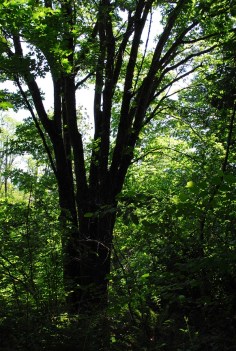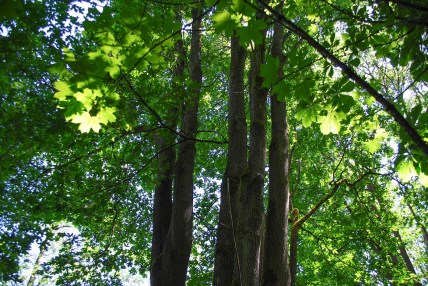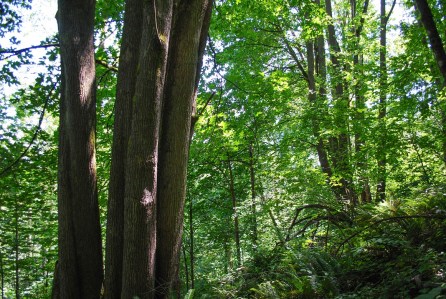 While walking in my local park, Camp Long, recently, I stopped to observe just how many multi-trunked maples there were. I had seen some before, but now I realized it seemed there were no single-trunk maples to be found. The Big-Leaf Maple is the only maple native to the Pacific Northwest. Since relocating from the east coast, I find it so easy to identify maple trees here. I simply declare them “Big Leaf,” and just double checking the leaves, reassure myself that I am brilliantly correct. The leaves, in fact, c
While walking in my local park, Camp Long, recently, I stopped to observe just how many multi-trunked maples there were. I had seen some before, but now I realized it seemed there were no single-trunk maples to be found. The Big-Leaf Maple is the only maple native to the Pacific Northwest. Since relocating from the east coast, I find it so easy to identify maple trees here. I simply declare them “Big Leaf,” and just double checking the leaves, reassure myself that I am brilliantly correct. The leaves, in fact, c an be HUGE!
an be HUGE!
Digression I
Were I on the east coast, maple identification would be trickier. The same goes for oaks. In the Northwest, we have only one native, the Garry Oak, and it’s uncommon at that. Whenever I’m in the presence of one, I feel I must pay my respects. They need a particular ecosystem to thrive, a type of prairie that has grassy savannahs and gravelly dry soils. These meadow communities support grasses, wildflowers and oaks. According to the Washington Native Plant Society, where these prairies still exist, the Garry Oaks have stood as long as 300 years. The society notes that such ecosystems are threatened by human development and encroaching Douglas firs. It seems badly ironic that one native species can push out another.
But, to end my comments on oaks: the eastern states have a plethora of oak species that fall into either the white oaks or the red oaks. That sends me to my field guides for IDs.
Digression II
I’m grateful for some simplicity in the Northwest. However, things are not so singular and simple when it comes to conifers. I am somewhat embarrassed to admit that even after taking classes, I am still stymied by the range of fir, spruce and pine trees here.
I am pretty confident in identifying western red cedars. I have one in my front yard. The tiny cones are the giveaway for me. Douglas firs, ah I have sweet memories of former Christmas trees named Doug. Doug firs have pale gray-colored trunks that rise straight as telephone poles. That’s my giveaway. And if I see small cones around the tree that have little fringes at the top, I know for sure it’s a Douglas fir.
 The World of Big-Leaf Maples
The World of Big-Leaf Maples
Big-Leaf maples, Acer macrophyllum, play a multifaceted role in the forest. Not only do they provide food and shelter for numerous birds and wildlife, they also host other plants. Moss, lichens and licorice ferns grow on the bark.

They grow rapidly and can reach 100 feet high and 50 feet wide at the canopy. These trees live up to their name. While the trees are large, their five-lobed leaves are the largest of the maples. Every fall, when the golden leaves start to cover the ground, I like to try to find the biggest leaf.

Multiple Trunks
But the most fascinating thing to me about big-leaf maples is their habit. The original trunks diverge into several others, which I will call siblings. And then, even some of the siblings further branch off!

I had to find out whether this was normal or just random. In some ways, they reminded me of celery, with many stalks rising from the base.

 Upon some light research I confirmed that big-leaf maples do grow this way and it is quite normal. In fact, it would be abnormal to have a 100-foot tall big-leaf maple that had only one trunk. I doubt that ever occurs. The result is, as you walk through the woods, you experience a landscape that is richly layered, not monotonous.
Upon some light research I confirmed that big-leaf maples do grow this way and it is quite normal. In fact, it would be abnormal to have a 100-foot tall big-leaf maple that had only one trunk. I doubt that ever occurs. The result is, as you walk through the woods, you experience a landscape that is richly layered, not monotonous.
 There’s not a single-trunked tree here and a single-trunked tree there. There’s a maple with five massive trunks here, and one beyond with six, and for every tree, the height at which the trunks join or diverge varies. Some siblings lean far out from the others. The bases of these mature trees are also interesting to study.
There’s not a single-trunked tree here and a single-trunked tree there. There’s a maple with five massive trunks here, and one beyond with six, and for every tree, the height at which the trunks join or diverge varies. Some siblings lean far out from the others. The bases of these mature trees are also interesting to study.

 The national champion Big-Leaf Maple is listed by American Forests as standing in Lane, Oregon, at 119 feet high, and 91 feet across the crown!
The national champion Big-Leaf Maple is listed by American Forests as standing in Lane, Oregon, at 119 feet high, and 91 feet across the crown!
No doubt these trees dominate the forest and are vital to the ecosystem. Other big companions include conifers, madrones, buckeyes (horsechestnuts), alders and poplars.
I’m grateful that even though my park is heavily used by humans, it has a good variety of native plants and provides habitat for wildlife.







